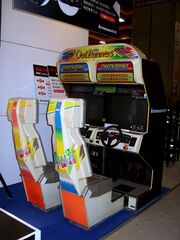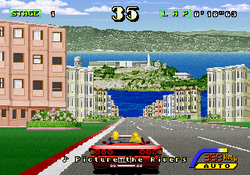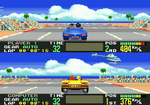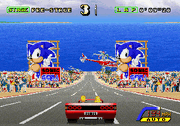OutRunners is a racing video game developed by AM1 and released by Sega in 1992. It constitutes the third release in the arcade Out Run series and was ported to the Mega Drive by Data East in 1994.
Description[ | ]

OutRunners two-player cabinet
OutRunners is the fourth game in the Out Run series, following Battle Out Run and Turbo Outrun. After Turbo Outrun's departure from Out Run's laid-back, charming atmosphere, fans wanted a game that captured the spirit of the original. OutRunners succeeded in doing this; it brought back the ability to take different paths through forks in the road, returned to a lighthearted atmosphere, and distanced itself well from the "serious" Turbo Outrun. The game featured head-to-head support, and with enough cabinets, up to eight players could challenge each other. It was also the only game in the Out Run series to feature various selectable cars and multiple endings until OutRun 2. OutRunners was the most successful game released for Sega's System Multi 32 hardware, and one of the last successful 2D games released by Sega. OutRunners was also known for having some of the best looking graphics seen at the time, thanks to creative sprite design and a very skillful use of parallax scrolling, similar to that found in Power Drift, released four years earlier. The game holds up very well today, and plays very similarly to a modern polygon based 3D racer, something not common in a racing game that utilises 2D graphics.
Unlike the original Out Run, some stages are accessible on more than one route combination. After the initial starting stage, the player has the option of either turning east or west. West leads through San Francisco, through the Easter Islands, into Asia and either into Africa or Europe. East goes through the Grand Canyon, South America or Niagara Falls, across the Atlantic Ocean, into Europe and either into Asia or Australia.
Course starting from San Francisco[ | ]
| Stage Number | ||||
|---|---|---|---|---|
| 1 | 2 | 3 | 4 | Goal |
| Kenya | ||||
| Egypt | ||||
| Hong Kong | Spain | |||
| Pacific Ocean Crossway Bridge | Mediterranean Sea | |||
| San Francisco | Japan | Atlantic Ocean Underwater Tunnel | ||
| Hawaii | France | |||
| China | Switzerland | |||
| Germany | ||||
| Northern Europe | ||||
Course starting from the Grand Canyon[ | ]
| Stage Number | ||||
|---|---|---|---|---|
| 1 | 2 | 3 | 4 | Goal |
| Russia | ||||
| Germany | ||||
| Switzerland | China | |||
| Niagara Falls | France | |||
| Grand Canyon | Atlantic Ocean Underwater Tunnel | Japan | ||
| South America | Mediterranean Sea | |||
| Spain | Hong Kong | |||
| Egypt | ||||
| Australia | ||||
All of the selectable cars in OutRunners are fictional convertibles, but bear resemblance to real automobiles. Notably, the Speed Buster closely resembles the Ferrari Testarossa featured in the original OutRun. Each car has its own set of a driver and passenger character, and have their own unique ending vignette if the player makes it to a goal. Each car has its own number of gears for Manual transmission ranging from two to six.
| Name | Color | Real-life equivalent | Transmission | Notes |
|---|---|---|---|---|
| Easy Handling | blue | Porsche 914 | 5-Speed | Home course is Kenya |
| Smooth Operator | silver | Acura NSX | 2-Speed | Home course is Japan |
| Bad Boy | black | Shelby Cobra | 5-Speed | Home course is South America, passenger and driver resemble Thelma & Louise |
| The Road Monster | pink | Cadillac Eldorado | 3-Speed | Home course is Australia, driver is an Elvis impersonator |
| Quick Reactor | orange | Fiat 500 | 4-Speed | Home course is Russia |
| Wild Chaser | green | Meyers Manx | 3-Speed | Home course is Hawaii |
| Mad Power | yellow | Lamborghini Countach | 6-Speed | Home course is Spain |
| Speed Buster | red | Ferrari Testarossa | 2-Speed | Home course is San Francisco and resembles original car from Out Run |
| Virtua Formula | red/white/blue | cameo appearance of car from Virtua Racing | 2-Speed | Secret car exclusive to Mega Drive port |
Music[ | ]

OutRunners allows the player to change the music track on the fly.
OutRunners featured all four of the songs from the original Out Run, as well as various new tracks.
The game was the first known to feature a voiced in-game DJ (Jake Elwood, perhaps a reference to The Blues Brothers), and allow the switching of songs and radio stations while playing the game; an idea that would later catch on in the Grand Theft Auto and Burnout series of games. Often not credited for creating this idea, it is quickly becoming ubiquitous in modern games.
- Magical Sound Shower (Speed Buster default music)
- Passing Breeze
- Splash Wave (Mad Power default music)
- Picture the Rivers (Smooth Operator default music)
- Blow Your Cool (Bad Boy default music)
- Looking for the Rainbow (Quick Reactor default music)
- Speed King (Easy Handling default music)
- Adventure (Wild Chaser default music)
- Sonic Control (The Road Monster default music)
- Last Wave
- Meaning of the Light (route map music)
- Mega Driver (car selection music, perhaps a pun on the name "Sega Mega Drive")
- Jingle Bells (hidden music)
- Dream Flying (music after reaching final checkpoint, a guitar version of the Green Hill Zone music from Sonic the Hedgehog)
Also, when listening to the "Mega Radio Station" each stage has its own exclusive music relative to the area.
Ports[ | ]

The Mega Drive/Genesis port of the game forced a split-screen.
A port of the game was released for the Mega Drive/Genesis by Data East. It featured a forced split-screen in single player modes, where one screen focused on the player and the other on the AI - a gripe many buyers had with the game. Of course, this is because they had to convert a new 32-bit game onto an aging 16-bit console. Though the graphics were merely an adaptation of the arcade version, all other features of this version were kept intact, such as the original arcade soundtrack featuring four songs from the original Outrun.
Trivia[ | ]
Lists of miscellaneous information should be avoided. Please relocate any relevant information into appropriate sections or articles. (July 2008) |

Sonic appears on the billboards.
- An anthropomorphic broad bean character is featured on billboards and the start of the game called "Broad Bean," a parody of *Bibendum (the Michelin man), presumably the mascot of the fictional company sponsoring the race, Sam Spree.
In the Mega Drive version, both Sonic and Tails may fly by in a pair of Tornados and sprinkle the Sega logo onto the screen. Sonic can also be seen on various billboards in the first stage.[1]
